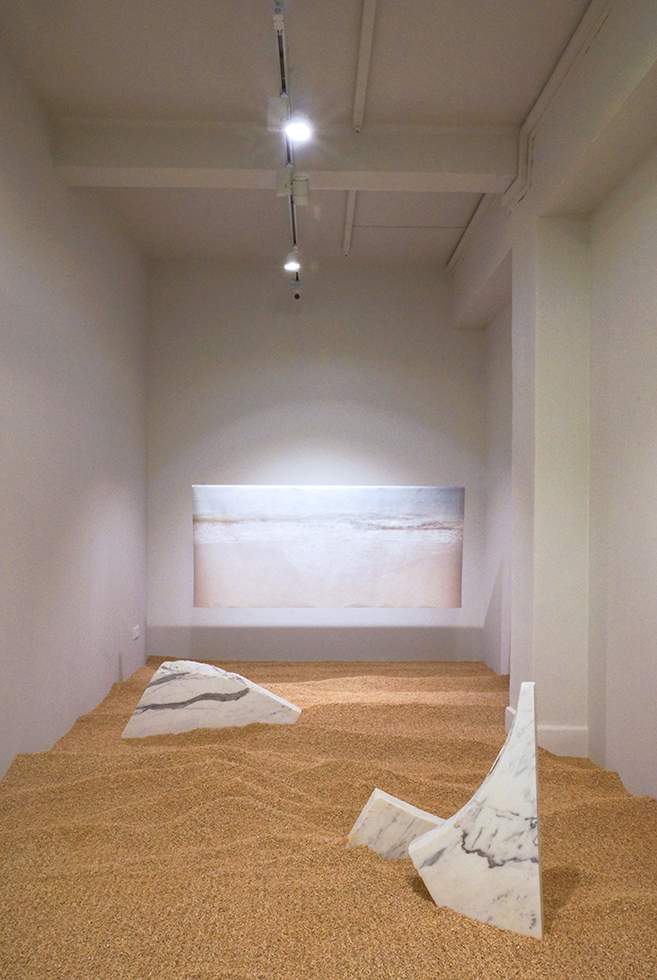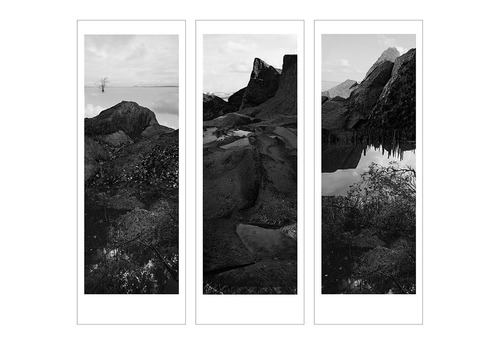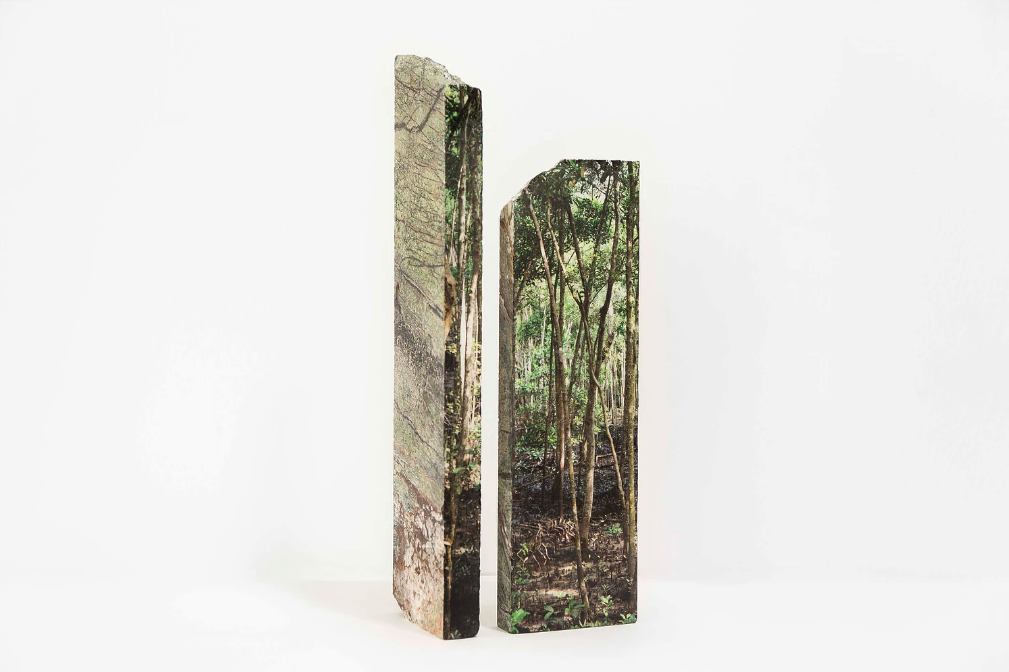“Growing up, I have been known to be a karung guni, which means junk collector. I recall that I loved collecting rubber tree seeds, flyers from mail boxes, flowers from weeds, playing with mimosa plants beside public stairs etc.“
– Zen Teh
Mizuma Gallery presents Mizuma Conversations, a series of in-depth interviews with featured artists. This time, we are featuring Zen Teh, a Singaporean artist.
Through this interview, we gain insights on Zen’s first exposure to the photographic medium, her artistic journey to become a photographer and her deep interest in the relationship between Man and Nature.
Read the full interview with Zen Teh here.
___________
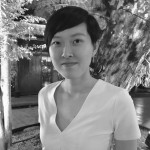 Zen Teh’s art practice is shaped primarily by her proficiency in photography and painting, alongside her continual investigation into the interdisciplinary studies of the interaction between nature and human behaviour. Situations where Man and Nature collide are highlighted in her body of works – each presenting a circumstance for the joint reaction of man and the environment.
Zen Teh’s art practice is shaped primarily by her proficiency in photography and painting, alongside her continual investigation into the interdisciplinary studies of the interaction between nature and human behaviour. Situations where Man and Nature collide are highlighted in her body of works – each presenting a circumstance for the joint reaction of man and the environment.
Zen graduated with a Bachelor of Fine Arts in Art, Design, Media, majoring in Photography and Digital Imaging from Nanyang Technological University, Singapore. Aside from her artistic practise, Zen serves as a visual arts educator at School of the Arts (SOTA), in the Media Arts Department. Her solo exhibitions include Vestiges: Tracing Urban-nature, Alliance Française de Singapour, Singapore (2017), and Sensing States: Healing Spaces, Art Science Museum, Singapore (2015). Zen has also exhibited regionally in Thailand, Taiwan and, China, as well as participated as an invited guest speaker at regional environmental conferences such as ASEAN Powershift 2015 and Hanoi Innovation Week 2016 on Sustainability. She has also been awarded the winning title for the 7th France+Singapore Photographic Arts Award. Zen lives and works in Singapore.
Mizuma Gallery (MG): Zen, when did you first start taking photographs?
Zen Teh (ZT): I started taking photographs when I was in secondary school. I remember my first digital camera was a very thick, and small camera that only has 7 megapixels. I bought it with my savings accumulated from my monthly allowance and I vividly recall that it was not the most fashionable camera, but it was the only camera I could afford. Shortly after, many new models of camera came out but I continued to use it until my school (junior college) had a camera that I could borrow. I recall the moment when I used my first digital camera, despite its unfashionable design, I was fascinated by the fact that I could capture scenes and details that I would not have been able to complete drawing before the scene changes. The camera also has a tiny LCD screen that allows me to play back the captured image – which really helped shape my art-making process!
The beginning of my image-making started when I was working on my O level artwork. Art was my favourite subject (of course!), and I was making a painting that combined different parts of human anatomy into an infinity symbol placed against a vast landscape. The painting style was inspired by Salvador Dali’s Soft Construction with Boiled Beans (1936), which presented the horrors of the Spanish Civil War, painted 6 months before the actual war broke out. I was inspired by the manipulation and construction of forms of the human body, and the spaces within a landscape. The camera was first used as a tool to study details of form to construct a manipulated human form.
MG: How did that lead you to become an artist? Can you talk a little about your formative years as an artist?
ZT: I am not sure how to define the beginning of being an artist. Looking back, I think it was always a combination of multiple inspirations and encounters of everyday incidents that gradually directed my pathway in art making. Since young, I have always been in love with the process of creation and art-making. When I was little, I loved drawing but was really poor at colouring. My drawings often depicted various scenes of people interacting with the spaces in my neighbourhood, and as children, the spaces drawn followed no strict concepts of perspective and proportions. There was always an element of play and non-linear composition of broad spaces. Like a doodle, the drawings were completely free-will, expressing a child’s perception of joy in everyday life.
Later in my teenage years, my artworks began to depict scenes of landscapes. I recall that I loved painting scenes of the sunset, where the foreground were in the shadows and the sunlight was backlit. Coloured with pastel, the silhouette of the foreground framed the scene and brought contrast to the vibrant sunset. Looking back, I was rather adamant to work on colouring techniques as I was poor at it when I was very young. Hence, I worked with a lot of colours, in pastel and paints in my works. The scenes I painted consisted of largely a single perspective, since the formal education of western perspective and space were taught in school. In addition, it was at this age when I started to use the camera as a tool to observe the things around me more closely. With the camera as a tool, it also became more time-specific, where light and shadow of a particular scene or object then also started to inform my paintings. It was also during this time that I adopted a vegetarian diet, which has stayed with me till today.
When I was in junior college, I was exposed to methods of collaging and was introduced to the works of Vieira Da Silva and Hong Sek Chern – whose paintings depicted a vast and seemingly boundless landscape that was truly inspiring. The abstract landscape seemed to extend beyond the confined frame of the canvas, leading the imagination of the viewers to extend the landscape in their minds. This unconventional use of space and perspectives reminds me of that childhood playfulness of my early drawings and the enjoyment of outdoor spaces. During this period, I was also exposed to Western Art History, where I was introduced to ideas of collaging through artists such as Man Ray, Robert Rauschenberg, and the expression through colours and tones of Abstract Expressionists such as Mark Rothko. A combination of these inspirations and observation of light and shadow of everyday forms brought about a 5-metre long painting of constructed space depicting a fluid space of multiple pathways, suggested by everyday architectural forms. Photography was used as a tool to study light and shadow of these architectural form to depict an abstract yet familiar space within the painting. This painting was titled Ad Infinitum which means endlessly in perpetuity.
True to the word, Ad Infinitum, the experience of constructing such a large painting was the start to my journey of exploration into collage and extended spaces, an on-going pursuit till today. My formal education in Photography began when I was studying in School of Art, Design and Media in Nanyang Technological University. I was fascinated by film photography and wet darkroom, a process I akin to painting on a canvas. Like painting, the use of exposure in zone system to envision the outcome of a work is like working on a painting, selecting the shades of colour and tone to achieve the desired outcome. I also began to achieve the know-how of medium, large format film photography, as well a digital imaging workflow. The precision needed in wet darkroom and film photography trained me to develop a perfectionist attitude, concerned with accuracy and details. At the same time, I was introduced to concepts of extended landscape using image juxtaposition in post-processing of photographs, and different cultural and artistic depictions of nature through my university module ‘Nature In Art & Visual Culture’. These influences drew further similarities between image making and painting, leading to my earliest extended landscape photography works, Unknowing and Singapore Landscape Painting. Both works explored the spatial compositions of Song Dynasty Landscape Painting in its expression of journey and time. At the same time, I started looking into a more spiritual understanding of the environment, in order to build a deeper understanding of how I, as a human being relate to and respond to the larger environment and universe. I looked into Buddhists and Taoist philosophies, which I relate to more non-religiously, and instead more spiritually, to draw understanding of harmony with our natural environment.
These early experiences shaped my art making trajectory, one which like nature, continues to evolve and surprise myself each time. It is a journey of discovery – like an adventure, where I uncover another means of expression through art making.
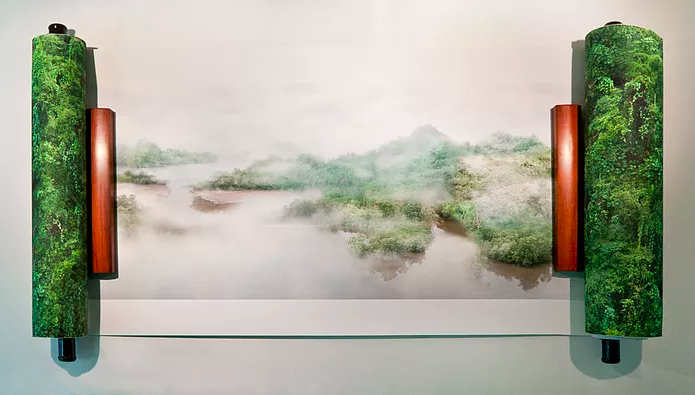
Zen Teh, Singapore Landscape Painting, 2012, inkjet print on archival Japanese handmade paper, 60 x 480 cm
MG: What made you first develop the interest in the relationship between nature and man?
ZT: Since I was a child, I have always enjoyed the outdoors and observations of the way things reveal their form and texture under the sun. I think the enjoyment of being outdoors is really important as it takes first hand encounter with elements of nature to be able to form understanding and muscle memory of tactile interaction with nature. Such experience sparks curiosity, open-mindedness and familiarity with natural elements. My parents played an important role in providing me such exposure, whether it is through selection of house location or leisure activities, there was always close proximity or association with greenery. Despite the dense population and urban development of Singapore, I grew up living near a beautiful granite quarry and later in an apartment close to a small natural hill. Running uphill to view the sunset was an everyday routine for more than 20 years that I lived in that house. From the top of the hill, I could comfortably overlook the buildings through to the sea in the distance. In the later years of living by the hill, this view became narrower as more buildings that were higher than older buildings were constructed. The area became more populated and I found myself reminiscing the broad view of the sunset against the sea. As the area became more developed and accessible, shopping centers and train stations were built, bringing about population from other towns into the area, transforming the lifestyle and interaction with the environment. Those were more distinct changes, but there were also small alterations to the ground, such as the numerous changes to existing tar roads, building of stairs, and recreational spaces. Looking back at these small changes, though difficult to recall and may even seem unworthy of remembering, but they too shaped my perception and memory of the land I grew up in. Growing up, I have been known to be a karung guni, which means junk collector. I recall that I loved collecting rubber tree seeds, flyers from mail boxes, flowers from weeds, playing with mimosa plants beside public stairs, etc. As the land and my immediate environment changed, so did my activities. Towards the end of my stay in the area, mimosa plants were no longer common, and in fact became difficult to find.
These memories of growing up helped build the foundation of my love for nature. Interactions with nature has always been a part of me and my lifestyle. Being a vegetarian since the age of 14 has also brought me to be increasingly more conscious of how food choices could impact the environment. Later exposure to meditation also brought about a deeper understanding of how I relate and respond to the environment and beyond. These memories juxtaposed with daily observations of the environment and its changes brought about constant questioning of what life could be, what the environment could be like, and how we could achieve balance (within ourselves and with the larger environment). This questioning, driven by both reminiscing of the past and thinking for the future, has manifested into artworks that remind viewers of various encounters and issues pertaining to the environment.
MG: What do you find most challenging about photography?
ZT: What I find most challenging about photography at this age is to be looking for a new or renewed way of communication that is meaningful and in tandem to technological advancement. Beyond giving a fresh perspective, these new expressions through photography should also be able to retain and place value in qualities of the photographic medium and workflow.
MG: You have recently exhibited a number of installation works. How did this expansion from photographic prints to installation begin?
ZT: As I continue to explore ways of presenting and experiencing photographs, I started to consider how meanings and experiences could be shaped by different viewpoints. I began to consider three-dimensional materials juxtaposed with two-dimensional photographs, such as Dual | Duel, In Between Spaces, and Garden State Palimpsest. Those works were created before the installations at Mizuma Gallery and OH! Open House. I was curious as to how an extended space that involves a larger volume of space and consideration of more elements would have an impact on the understanding of images.

Zen Teh, in collaboration with Product Designer, Sharifah Nasser, In Between Spaces, 2016, concrete and pigment, ink on colon rag paper, dimensions variable
MG: How does forming collaborative relationships with individuals of different backgrounds contribute to your artistic development and research?
ZT: Collaborations are platforms for intersections and interactions between different knowledge fields and perspectives. I find such collaborations beneficial and allows me to gain wider knowledge and find fresh perspectives towards issues of interest. Due to the difference in perspectives, sparks of creativity could be formed through active discussions and working together to create something meaningful. I have worked with ecologists, biologists, and scientists to create art-science projects and artworks to research on and to communicate environmental or medical issues. I have also worked with product designers, architectural researchers, and designers to expand and develop visual language.

Artwork by Zen Teh, in collaboration with designer, Sharifah Nasser, In Between Spaces (in progress), 2016, concrete and pigment, ink on cotton rag paper, dimensions variable
MG: What do you do besides photography?
ZT: Other than photography, I enjoy teaching, gardening and outdoor sporting activities.
MG: What are you currently working on and do you have any photographic or exhibition plans for the future?
ZT: I am currently working on an upcoming solo exhibition at ARTIST+RUN Gallery in Bangkok, an affiliated programme of “Photo Bangkok 2018” that is coming up on 25th August through 15 September. Later in the year, I will be going on a residency at Selasar Sunaryo Artspace in Bandung, Indonesia, to expand my research of the Anthropocene in Southeast Asia.

